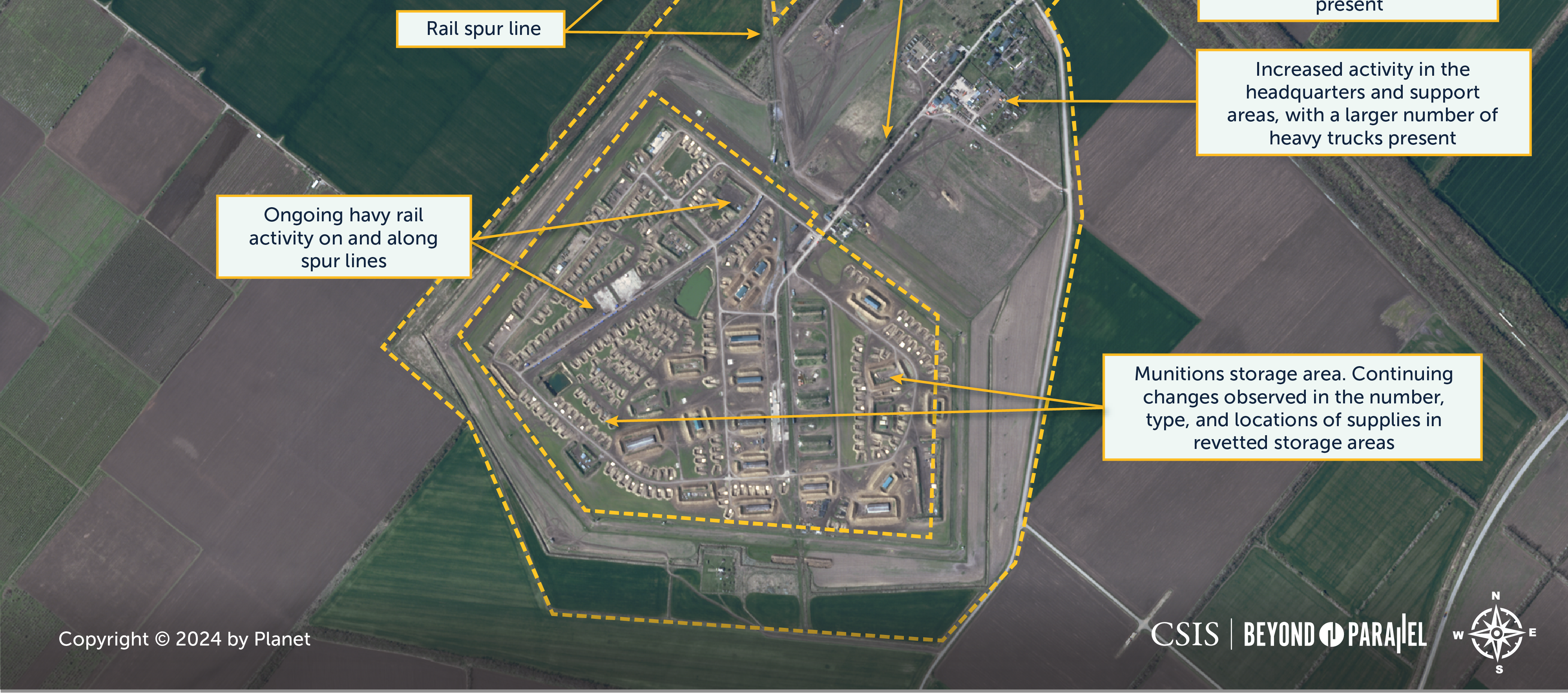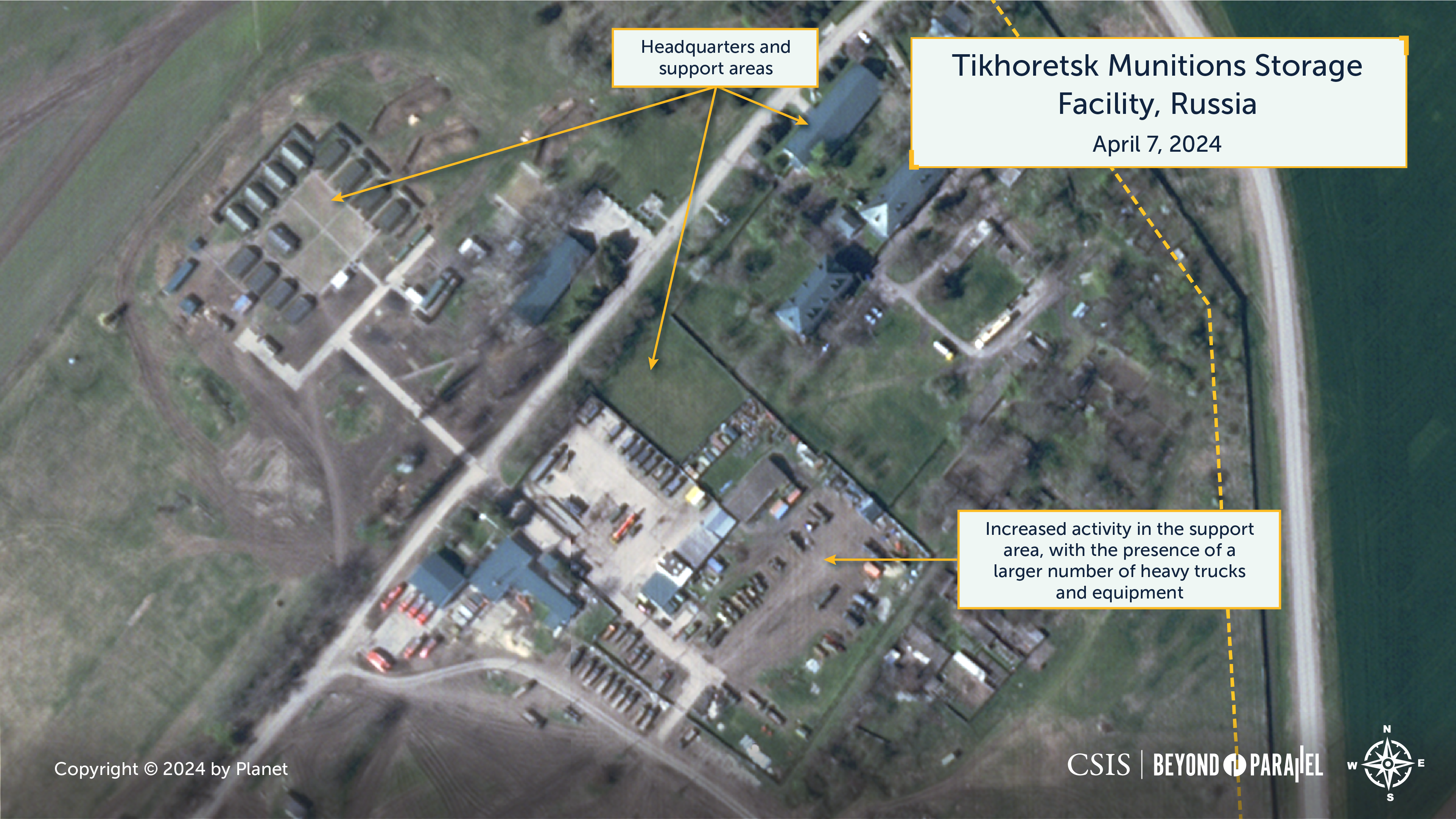
Ongoing Activity at Russia’s Tikhoretsk Munitions Storage Facility

Key Findings
- Satellite imagery from April 7, 2024, reveals an ongoing high-level utilization of the Tikhoretsk Munitions Storage Facility, with around 55% of its 280 storage revetments occupied—essentially the same as in February 2024.
- The number of railcars within the facility has decreased slightly to approximately 50 from approximately 60 in February. This, coupled with a decrease in storage/shipping containers and trailers along the facility’s access points, strongly suggests increased efficiency and experience in both rail and facility operations.
- Additionally, the ongoing fluctuations in the number of weapons systems and equipment present likely reflect adaptive operational strategies. An increase in the presence of trucks, vehicles, and equipment around the headquarters and support zones also indicates an uptick in the facility’s logistical and support operations.
- The dynamic activities captured in recent satellite imagery affirm the facility’s central role in the munitions supply chain, likely to persist in the foreseeable future.
- The White House has estimated at least 10,000 shipping containers of munitions and missiles have been transferred to Russia from DPRK. The South Korean defense ministry estimates 3.5 million rounds of ammunition have been provided by the DPRK to fill storage units like Tikhoretsk.
There are likely several Russian strategic munition storage facilities involved in the receipt of North Korean munitions shipments and their forwarding to the troops fighting on the Ukrainian front. Of these facilities, the munitions storage facilities at Tikhoretsk and Mozdok were confirmed specifically as storage sites involved in the North Korean-Russian munition shipments by the White House on October 13, 2023.
As detailed in our previous report, there was a dramatic increase in activity at both the Tikhoretsk and Mozdok Munitions Storage Facilities since the fall of 2023 and continuing through January 2024. A satellite image collected on April 7, 2024, of the Tikhoretsk Munitions Storage Facility confirms its ongoing high-level utilization, with around 55% of its 280 storage revetments being occupied—essentially the same as in February 2024. Given the layout and distribution of these revetments, it is likely that the various groupings of revetments are intentional and represent different classes of munitions, munitions for different field units, or a combination of these.

Approximately 50 railcars of different types are present along the facility’s railroad spur line, a slight decrease from approximately 60 in February 2024. Additionally, significantly fewer storage/shipping containers and trailers are distributed alongside the railroad spur line and main access road compared to February. This decrease strongly suggests increased experience and efficiencies in both rail and facility operations, combined with a probably more regularized delivery schedule. All of this has permitted excess storage/shipping containers to be more efficiently sorted and moved into storage revetments.
Ongoing fluctuation in the numbers of weapons systems, shipping containers, trailers, and equipment throughout the facility continues to be observed. For example, while approximately 30 artillery systems (likely 122mm) were grouped between two of the drive-through earth-covered magazines in January 2024, there are now approximately 29 systems of various types in five separate groups.


The number of trucks of various sizes, other vehicles, and miscellaneous equipment distributed around the headquarters and support areas has also increased. However, the number of civilian vehicles present at the facility’s entrance has significantly decreased since January 2024, likely due to increasing experience among the storage facility personnel and improved delivery timetables.

Given the October 2023 White House statement, the dramatic developments at the Tikhoretsk and Mozdok Munitions Storage Facilities, and the ongoing activities observed in current satellite imagery of the facility, it is likely that the Tikhoretsk Munitions Storage Facility will continue to serve as a strategically important munitions storage facility handling North Korean munitions deliveries to Russia for its ongoing war in Ukraine for the foreseeable future.
